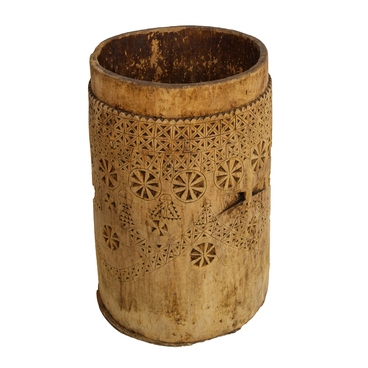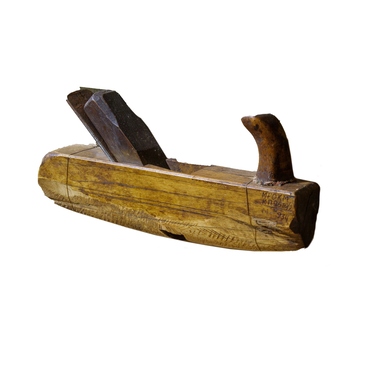A breaker is a tool for softening hemp, flax and other plant fibers. Its working part consists of two boards, and a third movable board is between them. This board is horizontally mounted on supports —"legs”: a wooden pole on one end and a fork of two branches on the other.
A breaker, which is “myalka”, “myalitsa” or “myaltsy” in Russian, appeared in ancient times. With its help, the fibers were separated from the hard wood shell — the boon. The tool was used until the end of the 19th century. The first breaker was made from the butt-log portion with a rootstock. The butt-log portion of the trunk is located right above the root.
A breaker looked like wooden trestles. The forked root of the tree formed its legs. A triangular batt, also called a “tongue”, was cut out of the log along its length. The width of the batt was a quarter of the log’s circumference or slightly less thick. The lower end of the batt was fastened to the log with either a ring of rods or a wooden axis. Thus, the batt turned into a knife-shaped movable lever. It broke the boon of the flax stem in the resulting trough.
Craftswomen carefully processed dry, brittle and splintery fibers before spinning. The stems of hemp or flax, previously retted and dried, were laid across the logs and stretched evenly towards the masters, hitting stems with the upper log.
The inner core of the stem broke as the result of the sharp blows of the batt. The fibers were ground until they became soft and the hard inner core drop away from them. Then the stems were moved a little higher, and masters continued to break them. When half of the fiber was broken, they began to process the other part.
When starting to break flax, craftswomen had to pay special attention to the correct location of the stems, since when harvesting from the field, retting or spreading, when drying or transporting, they often got tangled and could lie in sheaves incorrectly. They had to be straightened, since with the wrong arrangement of the stems, the fiber obtained from them also lay incorrectly. The incorrect position of some fibers increased even after scutching, as they also dragged along neighboring fibers.
In this case, during the hatcheling, the strands of fibers crossed with others and were not allowed to pull straight fibers between the teeth. Considerable effort was required to pull them through, as a result of which the fibers were torn into short pieces. Such scraps could no longer be used to make yarn.
A breaker, which is “myalka”, “myalitsa” or “myaltsy” in Russian, appeared in ancient times. With its help, the fibers were separated from the hard wood shell — the boon. The tool was used until the end of the 19th century. The first breaker was made from the butt-log portion with a rootstock. The butt-log portion of the trunk is located right above the root.
A breaker looked like wooden trestles. The forked root of the tree formed its legs. A triangular batt, also called a “tongue”, was cut out of the log along its length. The width of the batt was a quarter of the log’s circumference or slightly less thick. The lower end of the batt was fastened to the log with either a ring of rods or a wooden axis. Thus, the batt turned into a knife-shaped movable lever. It broke the boon of the flax stem in the resulting trough.
Craftswomen carefully processed dry, brittle and splintery fibers before spinning. The stems of hemp or flax, previously retted and dried, were laid across the logs and stretched evenly towards the masters, hitting stems with the upper log.
The inner core of the stem broke as the result of the sharp blows of the batt. The fibers were ground until they became soft and the hard inner core drop away from them. Then the stems were moved a little higher, and masters continued to break them. When half of the fiber was broken, they began to process the other part.
When starting to break flax, craftswomen had to pay special attention to the correct location of the stems, since when harvesting from the field, retting or spreading, when drying or transporting, they often got tangled and could lie in sheaves incorrectly. They had to be straightened, since with the wrong arrangement of the stems, the fiber obtained from them also lay incorrectly. The incorrect position of some fibers increased even after scutching, as they also dragged along neighboring fibers.
In this case, during the hatcheling, the strands of fibers crossed with others and were not allowed to pull straight fibers between the teeth. Considerable effort was required to pull them through, as a result of which the fibers were torn into short pieces. Such scraps could no longer be used to make yarn.



